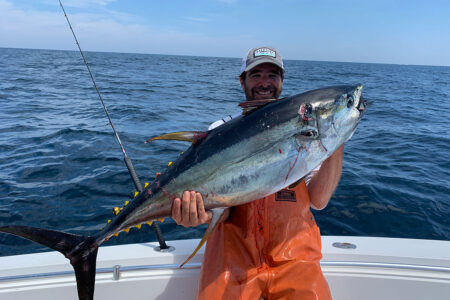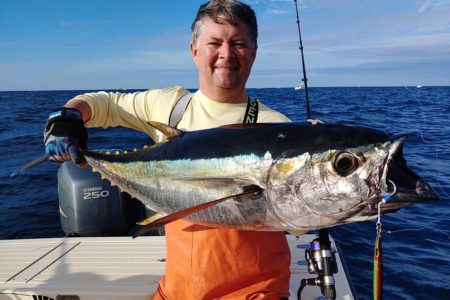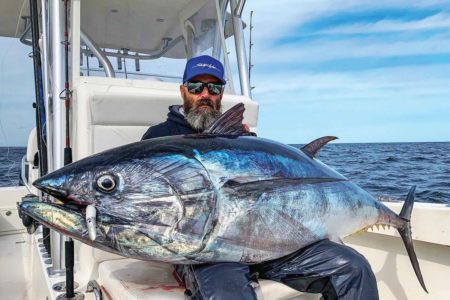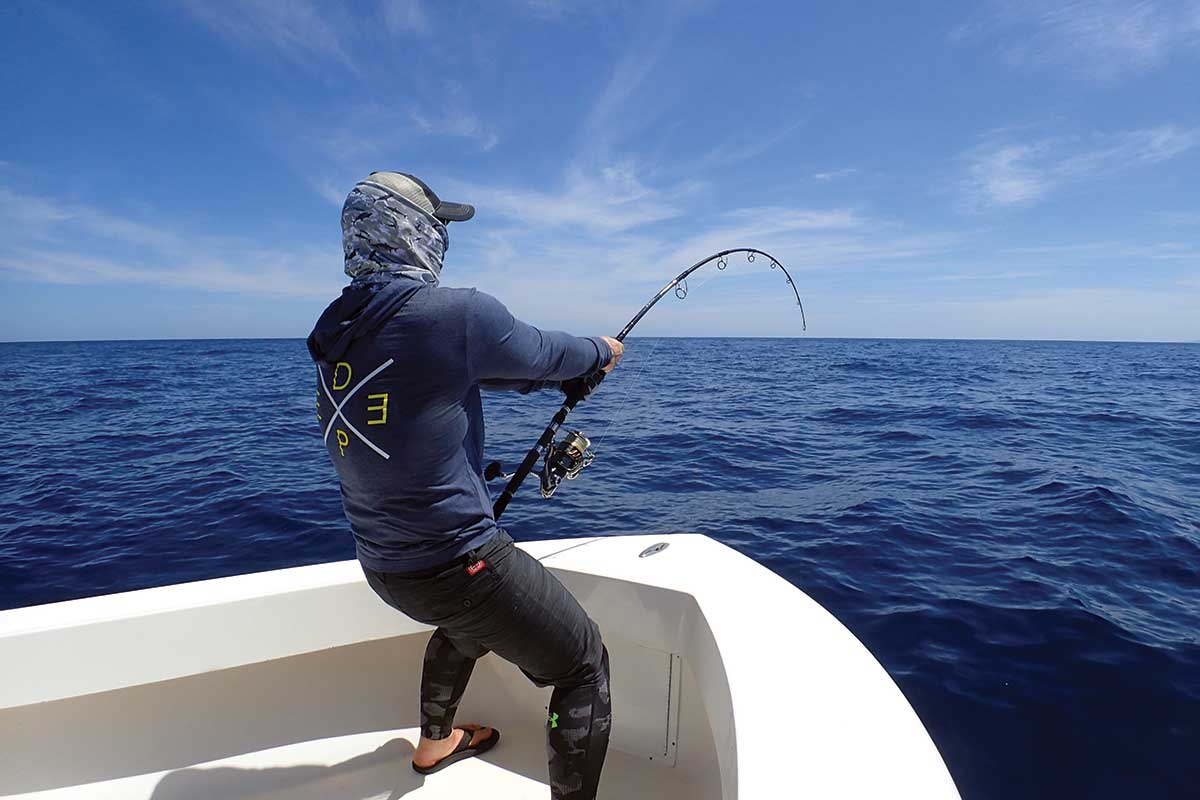
Technology has shifted the paradigm for big game spinning tackle dramatically in favor of the angler.
Hooking bluefin tuna on spinning rods is nothing new. Northeast anglers have been doing this on a regular basis since the 1990s, using modified surf reels and custom standup rods on the 15- to 20-fathom inshore grounds in the spring and typically near the 30- to 40-fathom wrecks during the summer and fall months. Most of the fish caught on spin gear in the past have been under 150 pounds, with many bigger fish lost to some sort of equipment failure. But these large school tuna are not the focus of this article, and small caliber spinning reels that max out with 15 or 20 pounds of drag have no place in this discussion. If you are hunting giants, you must use next-gen, strong and lightweight tackle that will bring these big fish to boatside and do it quickly. When hunting big tuna with spinning gear, the reel is a key component to success. Technology has shifted the paradigm for big game spinning tackle dramatically in favor of the fisherman over the past few years, so let’s get right into the art and science of understanding this revolution in big game hardware.
Next-Gen, High-Tech Machinery
Stella, Saltiga, Makaira, Torque II, VSB250, Salt-X – these are some of the names that have forever changed the bluefin tuna spinning game. All of these new wave spin reels feature machined aluminum frames for max strength when stressed under a load. Suffice it to say that when Daiwa first introduced their Saltiga series of high-end spinning reels back in 2002, the angling community took notice and the latest iteration of these reels is totally off the charts. I looked at an engineering photo of the drag stack on the 2020 Saltiga and the picture spoke 1,000 words. The previous generation Saltiga featured a low-profile main gear with a drag stack that consisted of a total of nine metal discs and carbon fiber washers. The recent generation Saltiga employs a 12 percent larger gear with 50 percent more gear meshing, using an Advanced Tournament Drag (ATD) system with 75 percent more drag surface, spreading the workload more evenly across the enhanced drag stack. The new ATD systems consists of nine carbon fiber washers, supported by nine durable metal washers, with the top and bottom of the matrix secured by stabilizing bearings that decrease wear and increase durability. Combine this with a heat-dissipating ABS spool design and a drag knob that draws heat out of the drag stack to cool off the drag during a long, drawn out fight. The result is 66 pounds of drag out of a reel that weighs a hair over 31 ounces!

There are similar stories to be told for the Shimano Stella, Penn’s Torque II, Okuma’s Makaira and the Van Staal lineup of big game spinning reels. Shimano introduced a quartet of updated Stellas last year, specifically the 8000PG, 8000HG, 10000PG and the 14000PG. The largest Stellas that are favorites of the bluefin run and gun crowd, the 14000, 18000 and 20000, can all crank in 55 pounds of tuna-stopping drag, while weighing in at a relatively svelte 24.3 ounces (14000), 30.9 ounces (18000) and 31.2 ounces (20000). Line capacity is critical on these run and gun tuna reels and again these big Stellas do not disappoint with 400 to 500 yards of superbraid storage, depending on the model and the line you choose to load onto the spool.
Predictably, the engineers at many of these companies mentioned the dreaded phrase “proprietary information” when I asked them about the makeup of their drags. Suffice to say if you can dial in 40, 50 or 60-plus pounds of braking ability, you will have a good chance at stopping a big bluefin, assuming that the rest of your gear and your physical state is up to the task. If you prefer a tuna spinner that’s assembled in America (from domestic and international parts), the Penn Torque II 7500 and 9500 reels could be just your ticket. The 7500 boasts 50 pounds of max drag while the 9500 can dial up 60 pounds. Weighing in at only 27.8 ounces they embody the concept of bigger, stronger and lighter. You can load up almost 400 yards of 65-pound superbraid on the 7500 Torque II, while her bigger sister will handle 490 yards of 80 or 425 yards of 100, more than enough capacity to run and gun 300- to 400-pound bluefin in shallower waters.
Okuma’s come a long way with their Makaira series of super spinners, with the two big guns in the lineup, the 20000 and the 30000 models, able to dial in a whopping 66 pounds of max drag with their advanced Dual Force Drag system. What I like about this design is that the front drag stack that nestles inside of the aluminum spool contains 10 alternating fiber and metal washers, stabilized on the top by a roller bearing. On the bottom of the spool, a full sized fiber wash and metal drag disc has been engineered to make complete contact with the entire diameter of the spool’s surface area, which maximizes efficiency and the ability to deliver high drag outputs. Line capacity is not an afterthought either, with the 20000 able to spool 400 yards of 80-pound superbraid and her larger sister handling 570 yards of 100-pound.
Relative newcomer Tsunami’s SaltX 6000 is no slouch to the middleweight tuna spin game, with 50 pounds of max drag, a 4.9:1 gear ratio, eight bearings and a bantam weight of only 18 ounces. The SaltX features a stainless steel main gear and shaft, seven sealed stainless steel ball bearings and a total of 14 seals throughout the reel to keep water, sand and salt on the outside, plus it’s submersible. However, her reduced line capacity of 300 yards of 50-pound braid will prevent her from battling the true heavyweights.
Talk to the Pros
Perhaps the best way to learn the tricks of the trade for landing small/large mediums and giant bluefin tuna on spinning gear is to get firsthand advice from the charter captains who make a living running and gunning for these prized thunnus. I had the chance to chat with three of the leaders in the field of spinning for giants, Capt. Dom Petrarca of Coastal Charters Sportfishing out of Plymouth, MA, Capt. Bobby Rice of Reel Deal Charters located in Truro, MA and Capt. Jack Sprengle of East Coast Charters based out of Rhode Island. If I had a word to describe these interviews, it would be a “revelation,” so let me pass along their words so that you can experience a similar shift in your thinking.
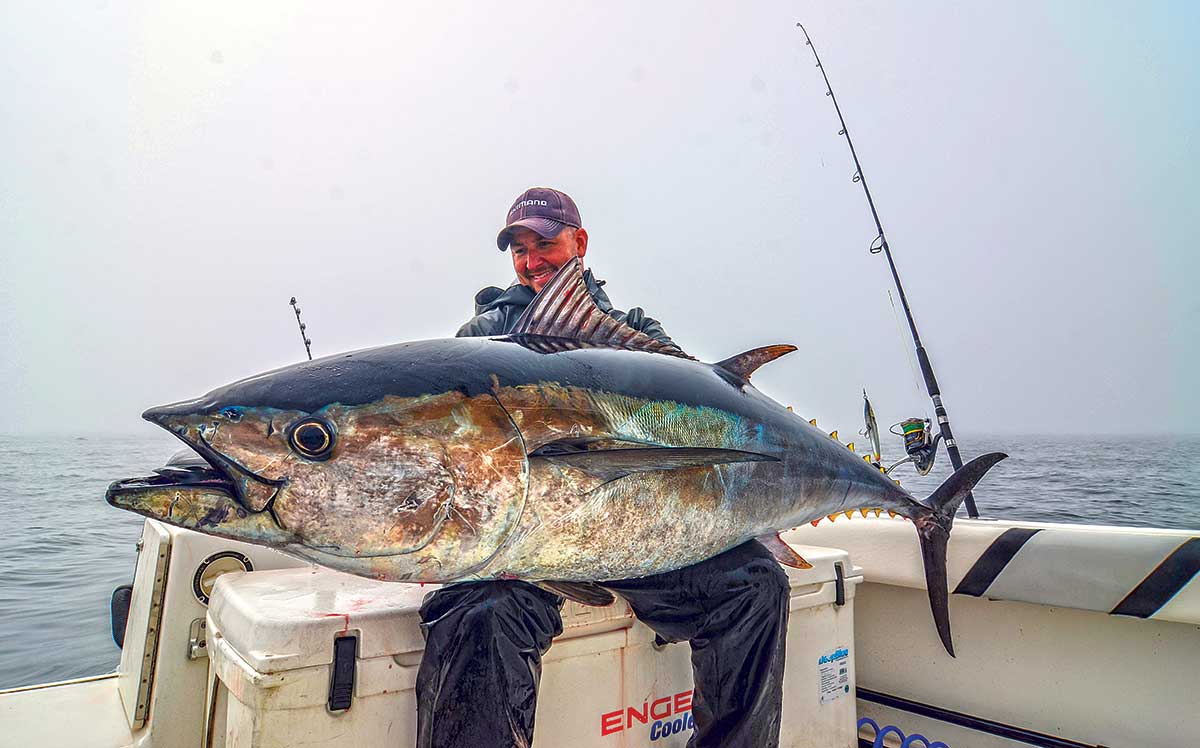
Capt. Dom Petrarca has caught and/or brought to boatside and released more oversized bluefin on spinning gear than just about any other angler on the planet. According to Capt. Dom, “I have been chasing bluefin tuna exclusively since 2006 and have landed over 50 giants on light tackle since my first in 2009, including four over 400 pounds, a 517 and a 597. All were gilled and gutted before weighing, so they were definitely heavier when brought aboard. Three much larger than the 597 pounder were released during temporary commercial closures the past two seasons. Much of chasing huge fish on tiny gear has to do with rigging and gear choices. There is of course proprietary stuff a particular captain might employ, something I feel I’ve mastered over the last 10 seasons.”
“I have rigged up the same way now for the past eight seasons for the large fish, with no variations. I employ a Shimano Stella 18000 spinning reel for casting, with a heavier Shimano 20000 for jigging. I also use Shimano Talica 16 single speed lever drag reels for conventional jigging. All are spooled up with either 80- or 100-pound TUF-Line Guide’s Choice hollow core super braid, using a loop-to-loop connection to a wind-on casting or jigging leader that varies between 80 to 130 pounds, depending on the situation. I have used BHP Tackle’s pre-made leaders in the past, but this season I will be introducing my own wind-on leaders in conjunction with Jigging World. For terminal tackle, we incorporate a 240-pound power swivel and either 255-pound power split ring or a 185-pound power split ring, depending on the choice of stick bait, popper, jig, etc. Hooks are 4x strong big game. The rods I use are Jigging World Ghost Hunter 200-gr casting and 450-gr jigging rods. All artificial lures and jigs must be through wired or rigged with an assist cord and hook to the mainline. The loop-to-loop system for connecting the leader to the running line is not only simple, it is bullet proof. The only knot I employ in the entire system is for 80- to 100-pound leader and it is my own slight variation of a Palomar knot. For 130-pound class leaders we only use crimps.”
Capt. Bobby Rice has been in the charter business for over 15 years, with more than 20 years of commercial fishing experience, running one of the first spin fishing for giant tuna charter businesses physically located in Cape Cod. According to Capt. Bobby, “A 423 pounder that we landed a few years back off the Cape was caught on a Point Jude jig, a Shimano Stella 18000 reel attached to a Van Staal 5-foot, 8-inch 500-gram jigging rod, using 80-pound Jerry Brown hollow core super braid spliced to 100-pound Seaguar fluorocarbon wind on leader. In recent years, we have caught multiple fish around or just over the 400-pound mark. A recent 400 pounder was taken on a Daiwa Dorado Slider with a Shimano Stella 20000 attached to a Ghost Hunter 7.5-foot 300-pound class rod. I continue to splice all my line as described above using Jerry Brown hollow core and Seaguar fluoro leaders. We also use other spinning gear on our bluefin charters, specifically a Van Staal VSB250.”
Capt. Jack Sprengel sent me a “brief” six-page summary on some of his favorite tackle and techniques for chasing giant bluefin on spinning gear. According to Capt. Jack, “Around 2010 I was introduced to a small clique of hardcore guys that had discovered schools of large-school bluefin tuna hanging inside of Cape Cod bay. These were fish from 80 to 120 pounds that were moving close to shore and willing to hammer top-water bass lures and large surface rigged plastics. We knew from our previous experience with smaller bluefin off of Rhode Island, that we were going to be very under-gunned for these fish, but did our best to put together powerful spinning set ups that would be capable of tangling with them. We matched heavy musky rods with the largest line capacity spinning reels we could find at the time, crimped on short heavy fluoro leaders and as with our first experiences, threw ourselves blind into the fray to learn from trial and error. The initial results were a mix of humbling and humiliating. We spent many 14-hour days, casting, hooking, holding on for dear life and then doing our best to avoid the inevitable catastrophic gear failure. Days of going 0-for-12 were commonplace. It seemed our backgrounds of inshore casting to selective species were serving us well in terms of hooking up; however our gear capabilities and our techniques for fighting these larger fish still needed a longer learning curve.”
“It didn’t take long for us to realize how important the strength and thin diameter of braided line would change the equation in our favor. We officially adopted 65-, 80- and 100-pound braid, which are still staples of the Northeast large tuna spin fishery to this day. But with the decision to commit to the heavy braid, a new set of problems arose. Burned out line rollers, melted drags and ground gear teeth on reels; plus rod guides that were literally sawed through or ripped completely off the rod; cracked reel seats; catastrophic blank failure due to compression and bending. Many popular salt-water spinning reels evolved to be larger in size, with heavier gearing, additional line capacity, with beefier drags, but they lived short lives under the abuse of this extreme fishery and almost always felt under-powered. When the Shimano Stella hit the scene it was lighter, stronger and more capable of the abuse that multiple bluefin battles in one day could exert on a reel. It was quite frankly the most remarkable piece of angling technology we had ever fished with at the time. After its introduction, it became the choice of extreme tuna hunters. One we could put our line on and give it hell.”
I will say one thing about the excellent tuna fishery described by all three of our guest captains and that theirs is a horizontal game of run and gun. Most of these large 350- to 600-pound fish are taken in 100 to 120 feet of water in Capt Cod Bay and the fight is typically one-dimensional in the horizontal plane. The fish have only one direction to go and that’s away from your boat as fast as possible. To enhance your chances of victory, be sure that your chosen spinning reel has a minimum line capacity of 400 to 450 yards of super braid and 50 pounds of drag, then run like the wind to catch up when the fish hits your lure or jig and takes off for the horizon at 40 mph.
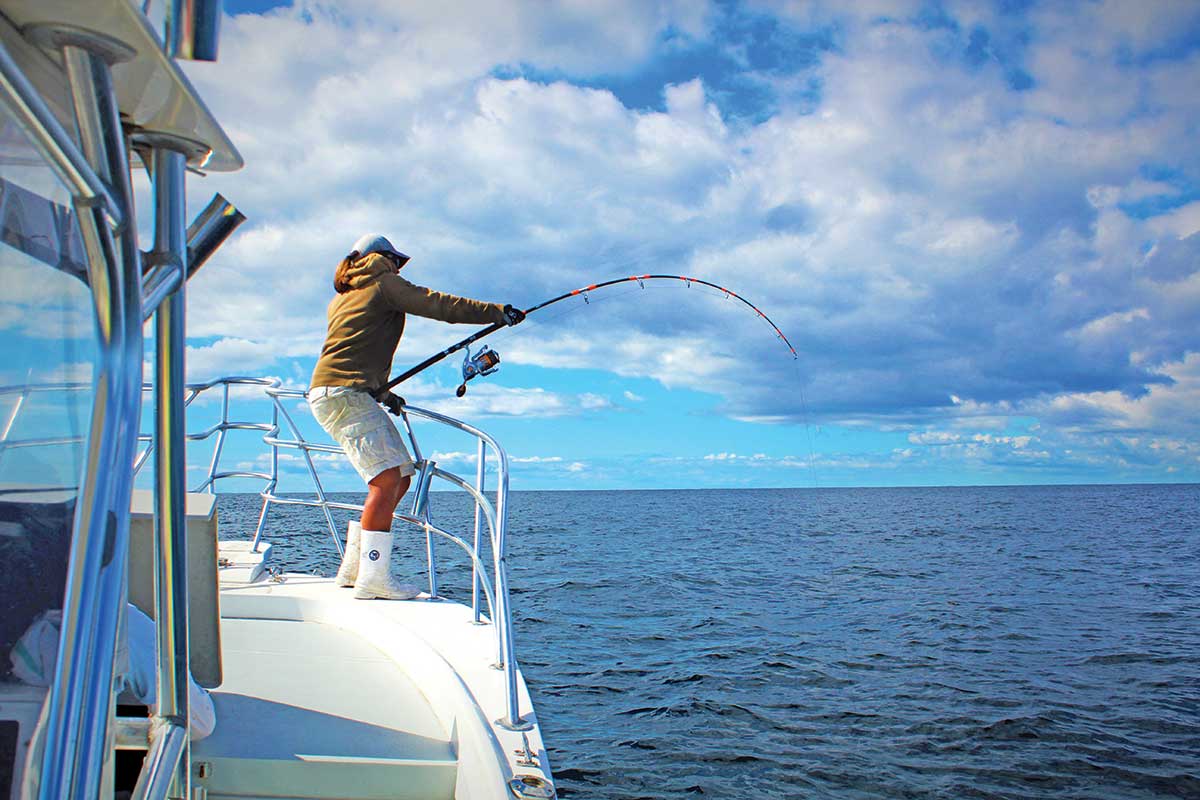
In contrast, I have personally hooked 23 bluefin in the 200- to 250-pound range in one frenetic morning and early afternoon of fishing, working the draggers near the edge of the Hudson Canyon back in 2004. This was not a one dimensional game, but definitely two-dimensional. We’d hook up one bluefin after another on bait in 350 to 400 feet of water on the east side of the Hudson near the Notch using Penn 30SW 2-speed reels spooled with 500 yards of 60-pound mono with no leaders. A minute into the fight, the hooked fish would make a beeline for the edge a few hundred yards to the west and head right down for the bottom in 200 fathoms taking 20 pounds of drag in the process. You don’t have to be a rocket scientist to realize that for the majority of the fight, we were staring at the gold spool arbor on our reels until we could apply enough pressure with the low gear on those 30s to get these fish back up to the surface. Of the 23 fish that we hooked, we brought a whopping total of only six bluefin to boatside, keeping two and releasing four. We snapped one standup rod in half, broke the reel seat on another, destroyed a half-dozen 4X Mustad hooks, burned out the drag and crunched the gears in one reel and popped the line on the rest of the “big ones that got away.” The point that I’m trying to make here is that these new next-gen super spinning reels will probably enhance your success on big bluefin in water depths of less than 180 feet, however, landing one of these 250- to 400-pounders on a single-speed spinner from 1,500 feet down, is a heck of a challenge.
Some Final Thoughts
The purpose of this article was to get you to think out of the box when it comes to targeting bluefin tuna on specialized spinning tackle. Most Fisherman readers have a shot at running into these fish less than 30 miles from home port and frequently a lot closer than that. I can tell you from firsthand experience, catching big tuna on light tackle is a blast and is quite an accomplishment. We are planning to spend more time covering the rods that enable these new-wave spinning reels to achieve their max capability, in addition to the line and the best connections to keep it all together, so stay tuned. If you have any questions, reach out to the charter captains who we interviewed, or send me an email at capt.john@att.net and we’ll get back to you as quickly as possible. Enjoy the journey!

